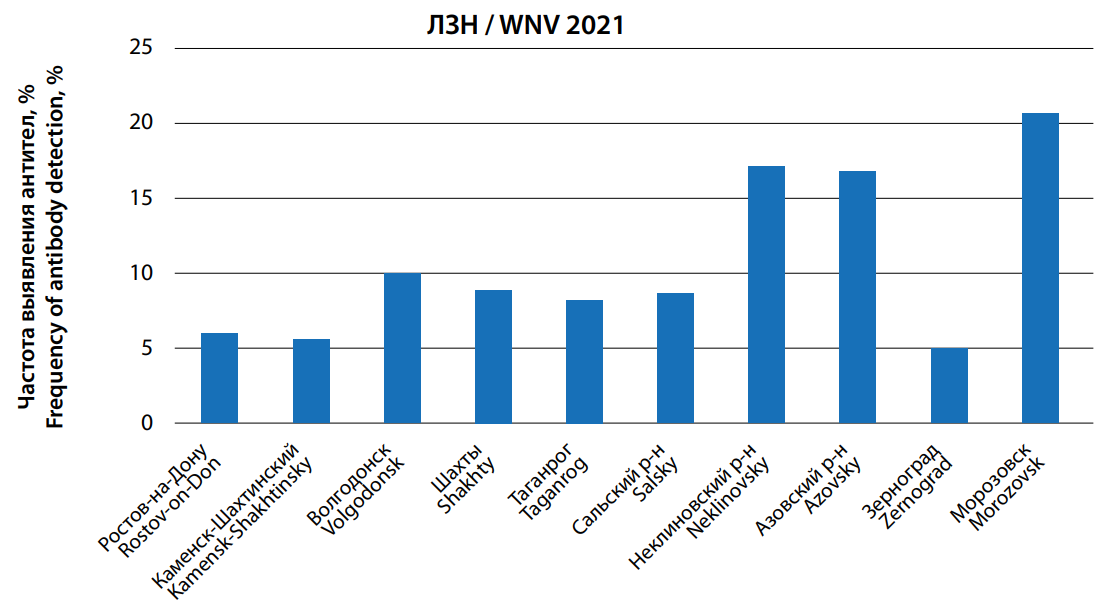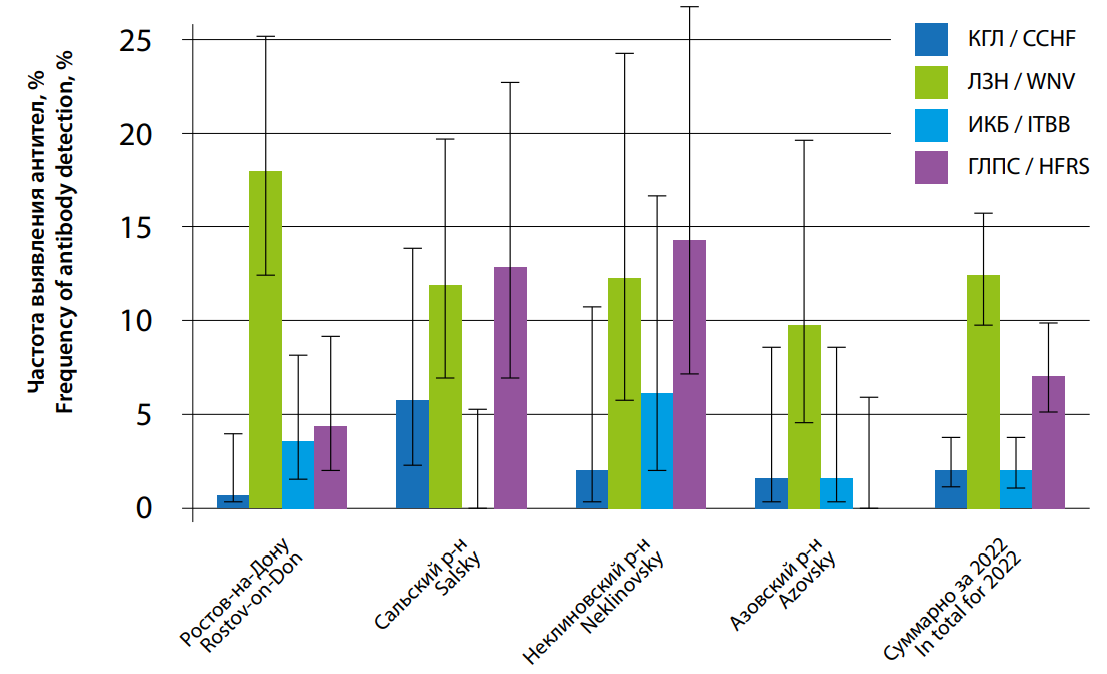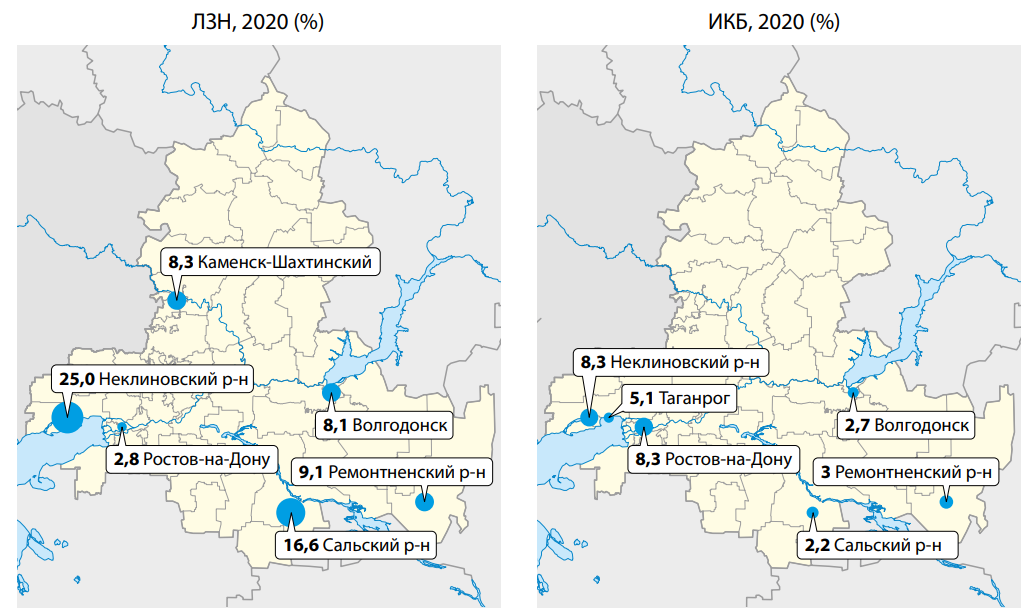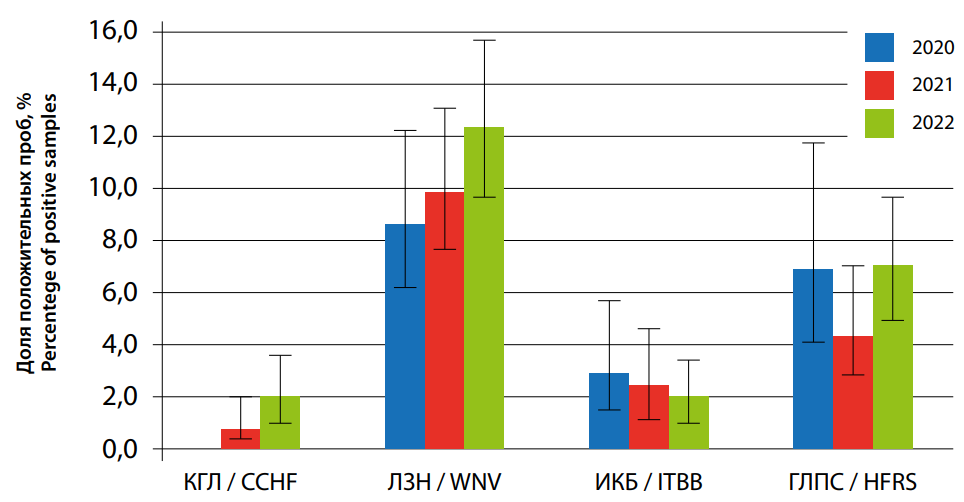Scroll to:
Assessment of the results of seromonitoring of natural focal infections using a database
https://doi.org/10.21886/2219-8075-2025-16-1-89-96
Abstract
Objective: is to analyze the effectiveness of the updated database of the serological monitoring on natural focal dis eases among healthy donors, which allows results accumulation and systematization in order to ensure sanitary and epidemio logical surveillance in the Rostov region. Materials and methods: for database creation we have used the results of the cross sectional studies of the level of the immune layer of the healthy population in the Rostov region during the period from 2020 to 2024 years. Marker indicators for assessing the level of immunity included the determination of immunoglobulins of G and M classes for topical natural focal infections by the immunoenzymometric method. Results: the database was based on Microsoft Office Excel and is used to store, to process and to structure information in a certain way, allowing us to sort and to filter, sup plement data in the process of work, to systematize information and to visualize source data in the form of graphs, diagrams, to conduct statistical analysis of the obtained data and to automate the filling of accounting (reference) documents. Conclusion: the information, which is accumulated in the database, provides quick access to information about regional seromonitoring studies.
For citations:
Trishina A.V., Bereznyak E.A., Pichurina N.L., Bereznyak Y.L., Lyukshina E.Y., Noskova O.A., Glushchenko E.I. Assessment of the results of seromonitoring of natural focal infections using a database. Medical Herald of the South of Russia. 2025;16(1):89-96. (In Russ.) https://doi.org/10.21886/2219-8075-2025-16-1-89-96
Introduction
According to the World Health Organization, the list of countries involved in epidemics associated with natural focal infections (NFIs) has been steadily expanding in recent times. Epidemiological surveillance of the incidence of a particular infection in a certain territory is an important public health tool that allows identifying trends in the development of the epidemic process, involvement of territories, time, and risk groups, as well as new pathogens1.
A feature of modern epidemic response measures is the use of all available means and decision-making based on actual data in real time. The accumulation of a large amount of information enables it to be used in practical healthcare and for research purposes to assess the spread of diseases and identify risk factors [1][2]. Currently, constantly updated databases (DBs) containing the main epidemiological data on present-day infectious diseases have been created and patented. In particular, the DB “Epidemiological Atlas of Russia” contains spatial and retrospective data on infectious and parasitic morbidity in the country; reference information on territories, nosologies, and affected contingents [3]; as well as a geoinformation portal on infectious diseases (cholera, anthrax, tick-borne hemorrhagic fever)2 and a DB on the incidence of tick-borne encephalitis and tick-borne borreliosis [4]; cholera [5]; tularemia [6]; hemorrhagic fever with renal syndrome (HFRS)3; post-vaccination immunity against plague [7] and many others.
To ensure sanitary and epidemiological well-being of the population at the regional level, it is necessary to solve analytical problems in order to predict the epidemiological situation in real time considering the characteristics of a specific territory to develop a set of measures aimed at minimizing the identified risks. A combination of various options for conducting analysis by one or more epidemiological parameters or nosologies allows optimizing and increasing the efficacy of anti-epidemic (preventive) measures [8]. Cross-sectional studies conducted at certain intervals provide valuable statistical information on the dynamics of morbidity and make it possible to describe and compare the structure of morbidity in the population in different regions of the country [9].
In recent times, serological methods have been considered a tool that completes epidemiological surveillance on the morbidity state and provides the generation of a large amount of information, helping to determine public health policy [10]. Laboratory-confirmed information on the level of population immunity in relation to actual infections makes it possible to assess the risk and degree of their epidemiological danger [11][12].
Statistical data on the structure of infectious diseases in the Rostov Region indicate a significant proportion of NFIs of viral and bacterial etiology. The largest proportion (88.7%) of registered NFIs accrues to Crimean hemorrhagic fever (CHF), West Nile fever (WNF) and ixodid tick-borne borreliosis (ITB). The remaining share is accounted for sporadic cases of pseudo-tuberculosis, yersiniosis, leptospirosis, brucellosis, tularemia, rabies, and Q4 fever4.
Seromonitoring studies conducted in the Rostov Region for 2020–2021 showed the presence of an immune layer among the healthy population to the pathogens of CHF, West Nile virus (WNV), ITB, HFRS, and tularemia [13]. To collect, store, and effectively analyze the information obtained during monitoring, an updated DB “Serological Monitoring of Natural Focal Infections in the Rostov Region” was created and registered. The DB has undergone the state registration procedure (Certificate of State Registration No. 2020621999 dated October 22, 2020).
The aim of the study is to evaluate the efficacy of using an updated DB of serological monitoring of NFIs among healthy donors, which enables the accumulation and systematization of results to provide sanitary and epidemiological surveillance in the Rostov Region.
Materials and methods
The DB was formed using the results of serological studies on the level of the immune layer of the healthy population of the Rostov Region, which were conducted at the Rostov-on-Don Anti-Plague Institute of Rospotrebnadzor since 2020 in order to assess the prevalence of NFIs circulating in the region.
Residual blood samples were obtained from healthy donors within the period from 2020 to 2024. During this time, residents of 15 municipalities of the Rostov Region were examined, including the city of Rostov-on-Don and towns of Kamensk-Shakhtinsky, Volgodonsk, Shakhty, Taganrog, Zernograd, and Morozovsk, as well as the administrative districts of Salsky, Remontnensky, Neklinovsky, Azovsky, Veselovsky, Zavetinsogoy, Tselinsky, and Aksaysky. The population of these areas amounts to approximately 2,344,000 people, which corresponds to 56.3% of the population of the Rostov Region. The selection of participants for the studies was carried out with regard to the donors’ permanent residence in various administrative territories of the Rostov Region and the absence of a history of previous NFIs. The biomaterial was obtained in accordance with the principles of legality and compliance with ethical standards. A total of 1990 samples of blood serums were tested during the specified period, namely 419 in 2020; 424 in 2021; 452 in 2022; 118 in 2023; and 577 in 2024. The age of the donors ranged from 8 to 90 years.
Marker indicators for assessing the level of immunity included determining the concentration of immunoglobulins of classes G to CHF, WNV, ITB, HFRS, and other NFIs. Specific antibodies in donor blood samples to NFI pathogens were determined by the enzyme-linked immunosorbent assay (ELISA). The work used registered test systems specified in SanPiN 3.3686-21 “Sanitary and Epidemiological Requirements for the Prevention of Infectious Diseases”. Serological monitoring and study of the immunological structure of the population to HFRS since 2023 were carried out in accordance with MU 3.1.3844-23 “Epidemic surveillance, laboratory diagnostics and prevention of hemorrhagic fever with renal syndrome” (January 27, 2023). ELISA was performed, and the results were interpreted according to the manufacturer’s instructions. The reaction results were recorded on an Infinite F50 microplate reader (Tecan, Austria).
The DB was created on the basis of LibreOffice Calc. The DB is regularly updated using the results obtained during the annual comprehensive serological monitoring of the NFIs.
Statistical processing of the results included calculation of the proportion of positive samples in each sample and 95% confidence interval (CI) according to Wilson’s method for the proportions of the immune layer using software provided by the website https://epitools.ausvet.com.au. The presence or absence of statistically significant differences was identified by comparing CI values.
Results
In order to provide the effective epidemiological surveillance system for actual NFIs circulating in endemic areas in the Rostov Region, the Rostov-on-Don Anti-Plague Institute of Rospotrebnadzor has been conducting comprehensive serological studies on the population immunity level of healthy donors against CHF, WNF, ITB, HFRS, and other dangerous zoonoses among residents of the region annually since 2020. As a result of seromonitoring, a large amount of information was accumulated that required analytical processing. In this context, it is worth noting that the DB makes it possible to assess the state of population immunity to current NFIs among residents of the Rostov Region in a specific period of time and in a specific territory and to graphically present the results of the studies.
The diagram provides an opportunity of a clear comparison of data series obtained from studying the level of immune layer to WNV in 424 healthy donors in 2021. Figure 1 shows the distribution of revealed specific antibodies to WNV in the towns as follows: 20.6% in Morozovsk, 10.0% in Volgodonsk, 8.9% in Shakhty, 8.2% in Taganrog, 5.9% in Rostov-on-Don, 5.6% in Kamensk-Shakhtinsky, and 5.0% in Zernograd; as well as in three administrative districts of the region: Neklinovsky (17.1%), Azovsky (16.7%), and Salsky (8.6%). The analysis of the obtained data makes it possible to conclude that, despite the low incidence of WNV in 2021, namely two laboratory-confirmed cases in the town of Bataysk and the Aksaysky district, a significant level of seroprevalence to WNV has been recorded among residents of large cities and districts of the region, which may indicate the circulation of WNV in these areas and the presence of immunity in the population after suffering from WNV in mild clinical or subclinical forms, as well as insufficient diagnosis of this disease among the population of the region.
The other diagram makes it possible to analyze the statistical significance of the revealed antibodies to the spectrum of studied infections for 2022 in certain administrative territories of the Rostov Region. Figure 2 shows that the highest frequency of detection of specific antibodies was found in samples collected in the city of Rostov-on-Don, as well as in Azovsky, Neklinovsky, and Salsky districts. As can be seen from the figure, the overlap of confidence intervals for the proportion of positive samples for each infection does not make it possible to draw a conclusion about the statistical significance of the observed differences.
It should also be noted that the overall results for the examined areas of the Rostov Region show high levels of immunity in the population to hantaviruses and WNV.
To ensure a comprehensive epidemiological assessment of the territory and to make management decisions, it is important to link the obtained results to the studied areas, which provides the possibility of solving regional problems on assessing the probability of diseases and targeted work on conducting epidemiological monitoring. Depending on the goal set in the DB, one can select a year and nosology in the original table, which will be interactively displayed on the Rostov Region map.
An example of using the DB is the distribution of samples seropositive to WNV and ITB over the territory of the Rostov Region (Figure 3). Thus, in 2020, despite the absence of registration of cases of ITB and WNV, IgG to WNV were detected in blood sera in almost all studied areas of the region, including the Rostov-on-Don city and Volgodonsk town, as well as Kamensk-Shakhtinsky, Neklinovsky, Salsky, and Remontnensky districts. Class G antibodies to ITB were detected in donors living in Rostov-on-Don city, Taganrog and Volgodonsk towns, as well as in Salsky, Remontnensky, and Neklinovsky districts. The obtained results make it possible to assume that the low incidence of WNV and ITB in the Rostov Region does not reflect the real epidemiological situation.
The annual update of the DB allows comparing the results for several major diseases and analyzing the change in the level of the immune layer over several years. An example of such a diagram is shown in Figure 4, which attests to the overlap of confidence intervals for the data obtained in 2020, 2021 and 2022 for each of the presented nosologies, indicating the absence of significant differences. Concurrently, the levels of specific Abs of class G to WNV are significantly higher than those to CHF and ITB.
As the current research tasks are solved, the DB is replenished with new nosological forms and participants. Thus, in 2022, after a long period of epidemiological well-being, 27 cases of Q fever were registered in three districts of the Rostov Region (Remontnensky, Salsky, and Tselinsky). Considering the epidemiological significance of this infectious disease, an epidemiological investigation was conducted. To clarify possible contacts of the population with the Coxiella burnetii pathogen in the districts, where cases of the disease were registered, serological screening was carried out among local residents. The investigation of blood serum from people exposed to the identical infection conditions showed that antibodies to the Q fever pathogen, belonging to class G, were detected in the age group from 11 to 54 years; 85.0% of cases were detected in men. In general, specific immunoglobulins to C. burnetii were registered in 7 of 120 blood serums, which corresponds to 5.8%.
Working with a DB allows anyone to analyze data groups of interest. Using filters allows searching the necessary elements in the table and selecting only the requested items. For example, to assess the age of donors seropositive to WNV, one can use sorting by positives of selected nosologies, and then the “age” field. Besides, working with the sampling, it was found, for instance, that in 2022, class G antibodies to WNV were detected in 60 individuals, which corresponds to 12.4% of the examined participants [ 9.8–15.6]. Upon this amount of initial data, the function MEDIAN was used to analyze age; median divides the data sorted in ascending order into two equal parts in the number of participants, showing the middle value of a set of numbers in a statistical distribution. The median age in this sample was 54 years, and seroprevalence to WNV was equally common among men and women.
In order to improve the quality of serological monitoring of WNF, studies were conducted to differentiate the acute form of the disease from the previous disease. In case of detection of IgG to WNV in the blood serum, the antibody avidity index was determined. In addition, to exclude cross-reactions between tick-borne encephalitis and WNV, class G antibodies to tick-borne encephalitis were determined. In 2022, the share of high-avidity antibodies was 76.7%; low-avidity antibodies covered 23.3% of the examined blood samples. Antibodies to the tick-borne viral encephalitis pathogen in a titer of 1:100 were detected in two blood serum samples of donors from the Neklinovsky District, while the avidity index to the WNF in these samples was 100%. New data have been added to the table to provide a more complete description of the situation with WNF in the Rostov Region.
A crucial task is to determine the prognosis of the development of the epidemiological situation using the DB of markers. The study of the conditionally healthy population in terms of NFI was continued in 2024. The results of 577 samples for WNF were analyzed. Class G antibodies to WNV were revealed in 13.5% of cases. Analysis of the results of seromonitoring for WNV obtained for the period from 2020 to 2024 showed a tendency to an increase in the proportion of positive samples. The total proportion of seropositive results was 8.7% [ 6.2–12.1] in 2020, 9.9% [ 7.4–13.1] in 2021, 12.4% [ 9.8–15.6] in 2022, and 13.5% [ 11.0–16.6] in 2024.
The seroprevalence rate in 2024 was the highest for all the time of observation. This fact indicates active contact of the population with the pathogen of WNF in the territory of the RR.
It is worth to note that the regular detection of high proportions of seropositive samples is stipulated by the development of subclinical, that is asymptomatic forms of infection in most cases (up to 80% of cases). Often, the fact of the disease remains unknown [14]. Based on the above data, one can assume that the incidence rate of WNF in the Rostov Region in 2024 may exceed the average long-term values.

Рисунок 1. Распределение специфических антител к ВЗН в 2021 г. в различных регионах области.
Figure 1. Distribution of characteristics of antibodies to WNV in 2021 in different regions of the region.

Рисунок 2. Частота выявления антител к ПОИ на отдельных территориях РО в 2022 г.
Figure 2. Frequency of detection of antibodies to the NFI in certain territories of the RR in 2022

Рисунок 3. Визуализация результатов серомониторинга в 2020 г. на карте Ростовской области
Figure 3. Visualization of the results of seromonitoring in 2020 on the map of the Rostov region

Рисунок 4. Уровень иммунной прослойки к ПОИ в РО в 2020–2022 гг.
Figure 4. The level of the immune layer to NFI in RR in 2020–2022
Discussion
Comprehensive blood serum studies give an opportunity to present a more complete picture of the infectious disease landscape in the Rostov Region. Since the data are updated dynamically, this makes it possible to use them both retrospectively and at the present time.
Studies based on a large number of observations have a high level of evidence that provides prediction of the epidemiological situation and increases the efficacy of epidemiological surveillance in the region.
Annual comprehensive epidemiological studies, including serological monitoring, makes it possible to identify the features of the functioning of natural and anthropurgic foci of NFIs with an epidemiological assessment of their activity.
Conclusions
The created DB makes it possible to register, store, and analyze data on the frequency of population infection with pathogens of NFIs in different years of research, being an effective tool for storage, analysis, and presentation.
The DB makes it possible “Serological monitoring of natural focal infections in the Rostov Region” provides quick access to information on the results of seromonitoring studies and the level of the immune layer of the population upon planning, organizing, and implementing preventive and anti-epidemic measures.
The operational and retrospective data obtained during immunological monitoring on the level of seroprevalence to NFIs in various administrative territories of the Rostov Region make it possible to predict the development of the epidemiological situation with natural focal diseases in the region.
1 World Health Organization. Global Strategy on Comprehensive Vaccine-Preventable Disease Surveillance. WHO, Geneva, Switzerland, 2020. Available at: https://www.who.int/immunization/monitoring_surveillance/burden/vpd/BLS20116_IA_Global_strategy.pdf. Accessed on 20 May 2024.
2 Geoinformation portal. Federal State Institution of Healthcare Rostov-on-Don Anti-Plague Institute of Rospotrebnadzor. Link available at: http://gis.antiplague.ru/index.php. Link active as of May 20, 2024.
3 Database of incidence of hemorrhagic fever with renal syndrome (HFRS) in the Republic of Tatarstan for 1959–2021. RU 2022621349 Patent Office: Russia. Publication year: 2022. Application number: 2022621188. Date of registration: 26.05.2022. Publication date: 08.06.2022.
4 Report on the state of sanitary and epidemiological well-being of the population of the Rostov Region in 2021 dated May 31, 2022. Available at: http://www.61.rospotrebnadzor.ru/index.php?option=com_content&view=category&layout=blog&id=96&Itemid=116. Link active as of May 20, 2024
References
1. Orlova N.V., Gorbunov K.S. Large databases in healthcare – opportunities and prospects. Medical alphabet. 2022;(25):8 11. (In Russ.) https://doi.org/10.33667/2078-5631-2022-25-8-11
2. Simonova E.G. Modern Stage of Development of the Epide miological Surveillance and Prospects of its Improvement. Epidemiology and Vaccinal Prevention. 2017;16(4):4-7. (In Russ.) https://doi.org/10.31631/2073-3046-2017-16-4-4-7
3. Sarskov S.A., Vyushkov M.V., Polyanina A.V., Slavin S.L., Zaitseva N.N. GIS Software Package “Epidemiological At las of Russia” on Current Infectious Diseases. Sovremennye tehnologii v medicine. 2023;15(6):22. (In Russ.) https://doi.org/10.17691/stm2023.15.6.03
4. Lesnykh S.I., Mel’nikova, O.V. Generation of Databases and Visualization of Current Epidemiological Information for Purposes of a Medical-Ecological Monitoring of a Region. Geogr. Nat. Resour. 2019;40:115–121. https://doi.org/10.1134/S1875372819020033
5. Vasil'eva O.V., Moskvitina S.I., Savel'ev V.N., Babenyshev B.V. Creation of the information system “Cholera in the Cauca sus”. Infection and immunity. 2012;2,(1–2):126. (In Russ.) eLIBRARY ID: 22451355 EDN: SxHwqN
6. Govorunov I.G. Problems of recording the incidence of tu laremia in the Russian Federation using databases. Bacteriol ogy. 2022;7(3):83-88. (In Russ.). https://doi.org/0.20953/2500-1027-2022-3-83-87
7. Kudryavtseva O.M., Kozhevnikov V.A., Yashechkin Yu.I., Bu gorkova S.A. Information support for monitoring post-vacci nation immunity against plague. Epidemiology and Vaccinal Prevention. 2021;20(3):76-82. (In Russ.) https://doi.org/10.31631/2073-3046-2021-20-3-76-82
8. Zhukov K.V., udovichenko S.K., Nikitin D.N., Viktorov D.V., Toporkov A.V. Application of Geographic Information Sys tems in epidemiological surveillance for west Nile Fever and other arbovirus infections at the modern stage. Infectious Diseases: News, Opinions, Training. 2021;10(2):16–24. (in Russ.). https://doi.org/10.33029/2305-3496-2021-10-2-16-24
9. Grjibovski A.M., Ivanov S.V. Cross-sectional studies in health sciences. Nauka i Zdravoohranenie. Science & Healthcare. 2015;(2):5-18. (In Russ.). eLIBRARY ID: 25052520 EDN: VCFVKP
10. Haselbeck AH, Im J, Prifti K, Marks F, Holm M, Zellweger RM. Serology as a Tool to Assess Infectious Disease Landscapes and Guide Public Health Policy. Pathogens. 2022;11(7):732. https://doi.org/10.3390/pathogens11070732
11. Negodenkoa A.О., Luchinin D.N., Konovalov P.S., Pavlyuko va O.A., Skrynnikova E.A., et al. A screening for serum mark ers of arbovirus infections in healthy blood donors from the Volgograd Region. Russian Journal of Infection and Immu nity. 2019;9(5-6):743-749. (In Russ.) https://doi.org/10.15789/2220-7619-2019-5-6-743-749
12. Negodenko A.O., Molchanova E.V., Prilepskaya D.R., Kon ovalov P.Sh., Pavlyukova O.A., et al. Analysis of the Results of Monitoring Arbovirus Infections in the Volgograd Region in 2019. Epidemiology and Vaccinal Prevention. 2021;20(1):51 59. (In Russ.) https://doi.org/10.31631/2073-3046-2021-20-1-51-59
13. Bereznyak E.A., Trishina A.V., Aronova N.V., Pichurina N.L., Egiazaryan L.A., et al. Evaluation of serological indicators of the presence of antibodies to pathogens of natural focal infec tions in the population of the Rostov region in 2021. Medical Herald of the South of Russia. 2023;14(1):75-82. (In Russ.) https://doi.org/10.21886/2219-8075-2023-14-1-75-82
14. Visentin A, Nasillo V, Marchetti M, Ferrarini I, Paolini R, et al. Clinical Characteristics and Outcome of west Nile Virus Infection in Patients with Lymphoid Neoplasms: An Italian Multicentre Study. Hemasphere. 2020;4(3):e395. https://doi.org/10.1097/HS9.0000000000000395
About the Authors
A. V. TrishinaRussian Federation
Alena V. Trishina, Cand. Sci. (Bio.), senior scientist re searcher of laboratories of natural focal and zoonotic infections
Rostov-on-Don
Competing Interests:
Authors declare no conflict of interest
E. A. Bereznyak
Russian Federation
Elena A. Bereznyak, Cand. Sci. (Bio.), senior scientist researcher of laboratories of natural focal and zoonotic infections
Rostov-on-Don
Competing Interests:
Authors declare no conflict of interest
N. L. Pichurina
Russian Federation
Natalya L. Pichurina, Cand. Sci. (Med.), the Head of laboratory of epidemiology of especially dangerous infections
Rostov-on-Don
Competing Interests:
Authors declare no conflict of interest
Y. L. Bereznyak
Russian Federation
Yury L. Bereznyak, Cand. Sci. (Bio.), Assistant Professor, Head of Physics Department
Rostov-on-Don
Competing Interests:
Authors declare no conflict of interest
E. Y. Lyukshina
Russian Federation
Elena Y. Lyukshina, Cand. Sci. (Med.), Senior Researcher at the Department of Professional Retraining and Advanced Training of Specialists
Rostov-on-Don
Competing Interests:
Authors declare no conflict of interest
O. A. Noskova
Russian Federation
Olga A. Noskova, Branch of Center for Hygiene and Epidemiology
Rostov-on-Don
Competing Interests:
Authors declare no conflict of interest
E. I. Glushchenko
Russian Federation
Elena I. Glushchenko, Branch of Center for Hygiene and Epidemiology
Rostov-on-Don
Competing Interests:
Authors declare no conflict of interest
Review
For citations:
Trishina A.V., Bereznyak E.A., Pichurina N.L., Bereznyak Y.L., Lyukshina E.Y., Noskova O.A., Glushchenko E.I. Assessment of the results of seromonitoring of natural focal infections using a database. Medical Herald of the South of Russia. 2025;16(1):89-96. (In Russ.) https://doi.org/10.21886/2219-8075-2025-16-1-89-96







































